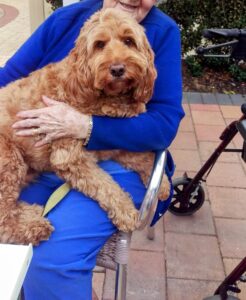Who doesn’t love dogs? They’re cute, cuddly and oh-so-loving. But did you know they can also serve as your personal therapist? Enter the world of Therapy Dogs!
Therapy dogs are trained pups offering emotional support to people in need, whether they be in hospitals, schools, or even airports. These dogs are not the same as service dogs as they don’t perform any specific tasks for a person with a disability. Instead, therapeutic dogs play soothing roles, helping individuals to relax and cope with anxiety, stress, and depression.
It’s not surprising that such furry companions can improve mental health. Research shows that stroking and petting dogs can reduce stress and anxiety hormones like cortisol, while simultaneously increasing happy hormones and feel-good neurotransmitters in the brain (Harvard Medical School. A little wagging of tails, nuzzling, and snuggling go a long way in influencing human well-being.
Dog therapy has become increasingly popular in recent years, with many organizations offering programs for seniors, hospital patients, and school children. Even airports have implemented therapy dog teams to help ease the stress of travel.
One specific group that benefits a lot from therapy dogs is children. Kids have been shown to have better self-esteem and social skills and lower anxiety in the presence of dogs (Fine et al.). The benefits of therapy dogs are numerous, including reducing stress and anxiety, improving mood and socialization, and increasing physical activity.
One major appeal of therapy dogs is their non-judgmental and unconditional love. They don’t care about our appearance or background, and they don’t hold grudges. A therapy dog simply wants to be by our side, offering their furry warmth and calming presence. Studies have shown that interacting with dogs can even lower blood pressure and decrease the risk of cardiovascular disease.
My dog George has been a therapy dog since he was two years old. He’s a Spoodle (Cockapoo, Doodle) and has a beautiful, calm temperament, ideal for working with the elderly and with children. Everybody loves George and he’s super friendly and chill.
Therapy dogs must pass rigorous health and behavior assessments to ensure they’re well-suited for the role. Animal-assisted therapy (AAT), as it’s called, also requires specific training and certification for both the handlers and canine companions (Smith & Matuszek). So, it’s not just about the cuteness factor.
Of course, not every pooch is cut out to be a therapy dog. Some breeds are more naturally suited to the job. Labradors and Golden Retrievers are popular therapy breeds due to their affectionate nature and easy-to-train personalities.
While the process of training and certifying therapy dogs sounds intense, the results make all the effort worthwhile. So, the next time you’re feeling down, instead of picking up your phone and scrolling through Instagram, why not cuddle with your furry friend or visit a therapy pet outside. After all, they say that dogs are a person’s best therapist!
REFERENCES:
Fine, A. H., Tedeschi, P., Elfenbein, H., & Rosenthal, S. (2015). The handbook on animal-assisted therapy: Theoretical foundations and guidelines for practice. Elsevier.
Harvard Health Publishing. (2018). The health benefits of dogs (and cats). Retrieved from: https://www.health.harvard.edu/staying-healthy/the-health-benefits-of-dogs-and-cats
Smith, M. C., & Matuszek, S. (2010). Animal-assisted therapy: An emerging opportunity in oncology. Journal of Oncology Practice, 6(6), e21-e23.
animal assisted therapycockapoodogdoodleoodleservice dogspoodletherapy dogs





